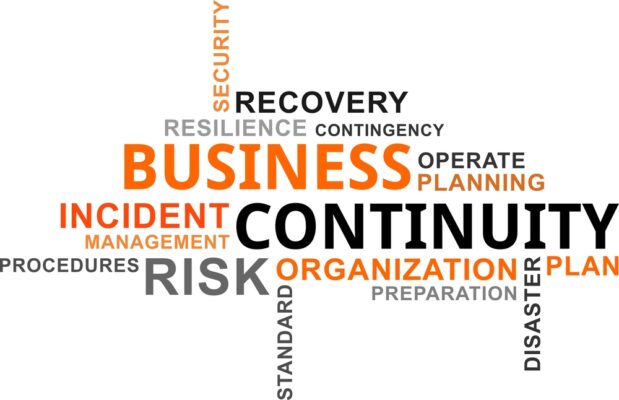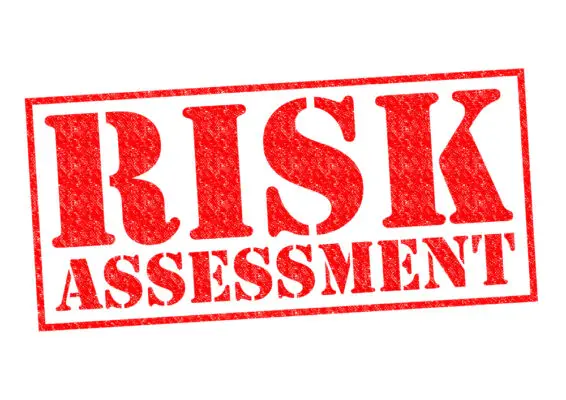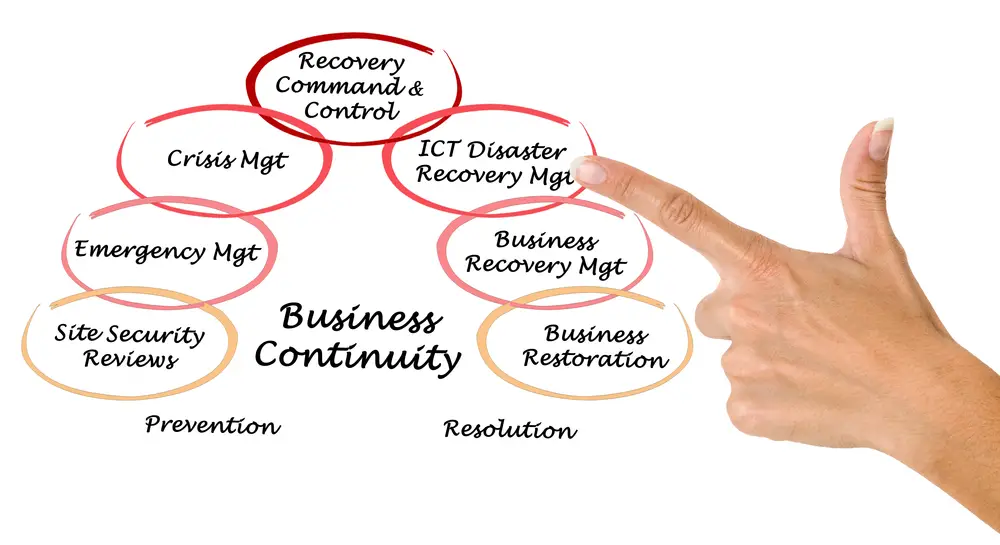Business continuity planning is a critical aspect of modern business operations. With the increasing frequency and severity of natural disasters, cyberattacks, and other unexpected events, organizations need to develop and implement robust plans to ensure that they can continue to operate in the face of disruptions.
Risk assessment is a crucial component of business continuity planning, as it helps organizations identify potential risks, evaluate their likelihood and potential impact, and develop strategies to prevent or mitigate them.
This article aims to provide a comprehensive overview of the importance of risk assessment in business continuity planning. It will explore common mistakes to avoid, the risk assessment process, the significance of business impact analysis, and cybersecurity policies.
In providing insights into best practices for conducting risk assessments, this article aims to help organizations ensure business continuity in the face of any unforeseen circumstances.

Overview
Understanding the process of evaluating potential hazards and prioritizing risks is fundamental to creating a comprehensive plan for ensuring the continuity of business operations in the face of unexpected disruptions.
Risk assessment is an essential step in Business Continuity Planning (BCP) as it systematically identifies potential threats and vulnerabilities that could disrupt operations.
It involves assessing the likelihood of an event occurring and the impact it would have on the organization. Risk assessment should be carried out before undertaking a Business Impact Analysis (BIA) as it helps identify potential threats that could impact critical business functions.
The BIA then evaluates the impact of these threats on business operations, allowing organizations to prioritize their response strategies.
A comprehensive risk assessment should identify potential threats, evaluate the likelihood of those threats occurring, and determine the potential impact on the organization. The ongoing risk assessment process should be reviewed and updated regularly to ensure it remains relevant and reflects the organization’s current risk posture.
To be effective, a risk assessment should be conducted by trained professionals who can identify potential threats and vulnerabilities and evaluate their potential impact on the organization.
A thorough Business Continuity Plan Risk Assessment should also consider the potential impact of large-scale natural disasters, such as hurricanes, floods, or earthquakes. While these events may be rare, their potential to cause large-scale disruption and damage is significant.
Businesses should analyze the likelihood of these events occurring in their region, the potential severity of the impacts, and the potential costs associated with any damages. Further, businesses should consider the impact of any potential disruption to their supply chain and the potential costs associated with lost or damaged inventory.
Finally, businesses should review their insurance policies to ensure they are adequately covered in the event of a large-scale natural disaster.
In addition to natural disasters, businesses should assess the risks posed by cyber-attacks, terrorism, and other criminal activities. Companies should review the security measures they have in place and consider any additional measures that may be necessary to protect their assets and operations.
Businesses should also consider the potential impacts of a cyber attack, such as lost or compromised data, stolen funds, and disruption to their operations. Furthermore, businesses should consider the potential costs of any losses or damages resulting from a cyber attack.
Common Mistakes
These mistakes include not accounting for the loss of critical people, not planning for staff stress and trauma, and not having alternative recovery sites.
The mistakes can lead to a lack of preparedness during unexpected events, which can have severe consequences for the business. For example, not accounting for the loss of critical people can result in a lack of expertise and knowledge, which can be detrimental to the smooth functioning of the organization.
Another common mistake in business continuity planning is not making emergency plans accessible. Emergency plans should be accessible to all employees, including those who work remotely. This can help ensure that everyone is on the same page and knows what to do when an unexpected event occurs.
Not communicating plans and processes transparently is also a mistake. Communication is essential during a crisis, and transparent communication can help build employee trust and confidence.
Not having alternative recovery sites is another mistake that can have severe consequences. If the primary recovery site is unavailable, the organization should have an alternative site ready to ensure continuity of business operations. Failure to plan for alternative recovery sites can lead to prolonged downtime, which can be costly for the business.
Overall, it is essential to avoid these common mistakes to ensure that the business is prepared to navigate unexpected events and maintain continuity of operations.
Risk Assessment Process
The process involves identifying and describing risks, prioritizing risks associated with essential recovery processes, and evaluating risks to compare results with the organization’s risk tolerance.
It is important to venture outside the scope of risk assessment to find information that supports evaluation and have workshops with the enterprise risk team to test the articulation of risks.
The risk assessment process should focus on risks that have the potential to disrupt the business recovery process during a disaster. Risks associated with processes essential to the organization’s recovery process should be identified, and unforeseeable risks should not be anticipated.
The identified risks should be closely related to overall business continuity, and mitigation controls should justify the investment to mitigate.
The findings from the risk assessment process will be valuable input in designing a business recovery strategy, which will be the next step in the program.
Overall, the risk assessment process is integral to business continuity planning. It helps organizations prepare for and mitigate risks, prevent injuries or illnesses, meet legal requirements, create awareness about hazards and risks, create an accurate inventory of available assets
Justify the cost of managing risks, determine the budget to remediate risks, and understand the return on investment. A specialized compliance specialist can help with the risk assessment process, and risk assessment plans should be reviewed and updated regularly to stay on top of new hazards.

Business Impact Analysis
The analysis involves identifying and assessing the potential consequences of disruptive events on critical business functions, assets, and stakeholders. It considers the time required for recovery, the cost of recovery, and the impact on revenue, reputation, and customer satisfaction.
The Business Impact Analysis enables organizations to prioritize recovery efforts and allocate resources effectively. It also helps them identify areas for improvement in their Business Continuity Plan.
Business Impact Analysis is an essential step in the risk assessment process for Business Continuity Planning. It helps organizations understand the potential impact of disruptive events on their operations, finances, and reputation.
Reporting and Review
Reporting and Review is a crucial step in the Business Impact Analysis process as it allows organizations to present their findings to stakeholders and obtain feedback. This feedback is important as it helps organizations to improve their Business Continuity Plan.
Reporting and Review also enable organizations to identify any gaps in their plan and make the necessary changes to better prepare for the risks identified during the risk assessment.
During the Reporting and Review process, it is important to use templates that are familiar to the enterprise risk team to report findings. These templates help to ensure consistency in reporting and make it easier for stakeholders to understand the findings.
It is also important to provide a high-level update to the steering committee and review the report with the GRC or enterprise risk management team. This review process helps to ensure that the findings are accurate and that the Business Continuity Plan is aligned with the enterprise risk management practices.
Reporting and Review is an essential step in the Business Impact Analysis process. The feedback obtained during this process is crucial in improving the Business Continuity Plan and ensuring that the organization is better prepared for the risks identified during the risk assessment process.

Conclusion
Risk assessment is a crucial component of business continuity planning that involves identifying and analyzing potential risks to an organization’s operations. It allows businesses to evaluate the likelihood and potential impact of various risks and develop strategies to prevent or mitigate them.
To ensure the success of a risk assessment process, organizations must avoid common mistakes, such as failing to involve key stakeholders or neglecting to update the assessment regularly.
Business impact analysis is also a critical aspect of risk assessment that helps organizations understand the potential consequences of a disruption and prioritize recovery efforts accordingly.
Additionally, cybersecurity policies must be integrated into the risk assessment process to address the increasing cyber-attack threat.
Implementing a comprehensive cybersecurity program that includes employee training and education, regular system and software updates, and up-to-date antivirus protection is important. Also, organizations should have a process in place to regularly review their policies and procedures to ensure they are up-to-date and in line with industry best practices.
Regular network activity monitoring should also be conducted to identify any suspicious activity and respond to potential threats quickly and effectively. Finally, organizations should develop a communication plan to ensure all staff and stakeholders are aware of the cybersecurity policies and related procedures.

Chris Ekai is a Risk Management expert with over 10 years of experience in the field. He has a Master’s(MSc) degree in Risk Management from University of Portsmouth and is a CPA and Finance professional. He currently works as a Content Manager at Risk Publishing, writing about Enterprise Risk Management, Business Continuity Management and Project Management.

